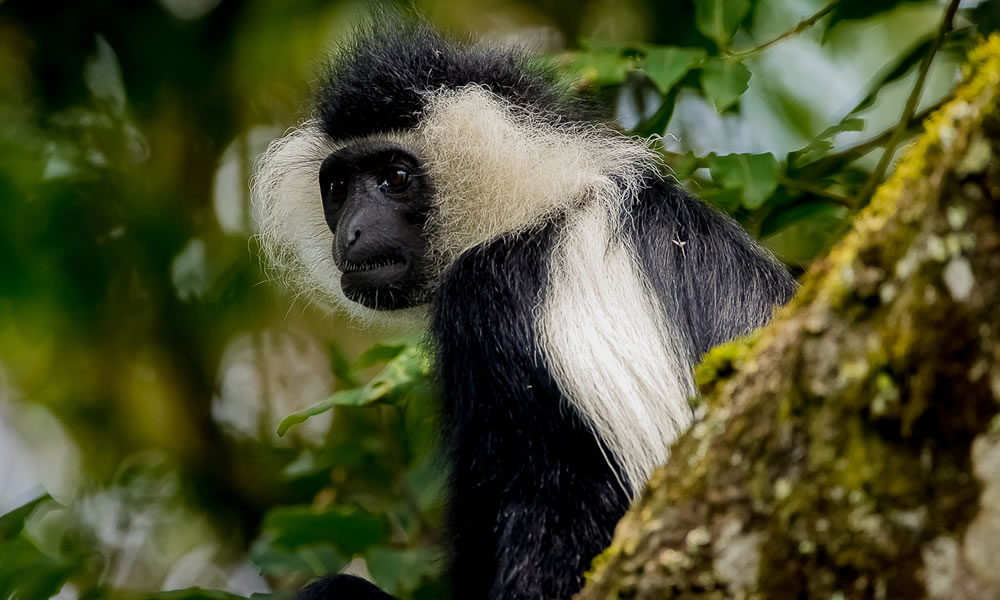Nyungwe Forest National Park in southwestern Rwanda is one of Africa’s most pristine montane rainforests, known for its incredible biodiversity. Tracking Colobus Monkeys in Nyungwe Forest National Park is an exciting activity you should not miss when you visit Nyungwe in Rwanda. While the park is famous for its chimpanzees, another equally captivating experience awaits visitors: tracking colobus monkeys. These striking black-and-white monkeys, with their long, flowing tails and social behaviors, offer a unique and rewarding wildlife encounter in the heart of the forest.

The Beauty of Colobus Monkeys
Colobus monkeys, particularly the Angolan colobus (Colobus angolensis), are the stars of this activity. Their distinctive black fur, contrasted with white fringes along their back and tails, makes them one of the most visually striking primates. Unlike many primate species, colobus monkeys do not have thumbs, a unique adaptation that aids their swift movement through the treetops.
In Nyungwe Forest National Park, these monkeys live in large social groups, sometimes numbering over 300 individuals—the largest known troop size in the region. Observing these groups in their natural habitat offers fascinating insights into their social interactions, grooming habits, and foraging behaviors.
The Experience of Tracking Colobus Monkeys
Tracking colobus monkeys in Nyungwe Forest is a guided activity that typically begins early in the morning. Visitors are led by knowledgeable park rangers who are experts at locating the monkeys within the vast expanse of the forest. The trek itself can vary in duration, depending on the monkeys’ location, but the journey is part of the adventure.
The trails wind through dense rainforest, with the sounds of chirping birds, rustling leaves, and distant animal calls creating an immersive experience. Along the way, visitors often encounter other wildlife, such as colorful birds, butterflies, and sometimes even other primates like blue monkeys and grey-cheeked mangabeys.
When the colobus monkeys are located, visitors are rewarded with an hour of observation, during which they can watch the monkeys leap gracefully between trees, play, and feed on leaves and fruits. Photography enthusiasts will find plenty of opportunities to capture these moments, though the dim forest light can be a fun challenge.
Conservation and Community Impact
The colobus monkey tracking experience is not just about tourism—it also plays a crucial role in conservation and community development. Nyungwe Forest National Park is a protected area, and the fees generated from activities like colobus tracking help fund conservation efforts, including anti-poaching patrols and habitat restoration.
Additionally, a portion of the revenue supports surrounding communities through education, healthcare, and infrastructure projects. This revenue-sharing model fosters a sense of ownership among local populations, encouraging them to protect the park and its wildlife.
Practical Tips for Visitors
Fitness Level: Tracking colobus monkeys involves hiking through sometimes steep and muddy trails, so a moderate level of fitness is recommended.
Gear: Wear sturdy hiking boots, long-sleeved clothing for protection, and carry a rain jacket, as Nyungwe is a rainforest with unpredictable weather.
Permits: A permit is required for colobus tracking and can be arranged through Rwanda Development Board or local tour operators.
Tracking colobus monkeys in Nyungwe Forest National Park is an unforgettable experience that combines adventure, wildlife observation, and a deeper understanding of Rwanda’s natural heritage. Whether you’re a seasoned primate enthusiast or a curious traveler, encountering these elegant monkeys in their lush habitat is an enriching journey that highlights the importance of conservation and sustainable tourism.
